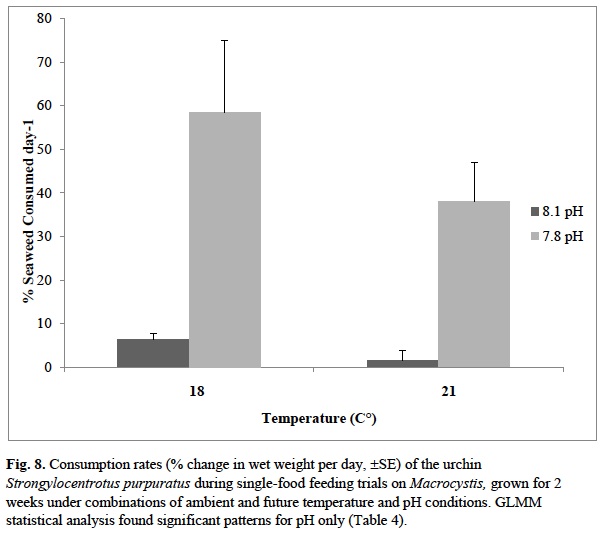Forward:
This thesis shows that purple urchins increase feeding rates by about 500% when exposed to acidified conditions that are currently occurring in Northern California during spring upwelling season. (see figure 8 below)
No wonder the kelp is all gone! Of course 150 purples per square meter can do plenty of damage without an increased feeding rate. The California Department of Fish and Wildlife documented purples in those concentrations across their abalone survey transects. (See https://cdfwmarine.wordpress.com/2016/03/30/ perfect-storm-decimates-kelp/)
This paper doesn’t show how the gonad index responds with the increased feeding rates because the experiments didn’t run that long, but if the gonads can increase along with feeding rates, then purples will just take over under acidified conditions, as is happening now. Of course the gonads won’t increase when they run out of kelp to eat .
We need to set up some experiments to research how the gonad index responds with the increased feeding rates by pumping extra CO2 into seawater tanks under controlled conditions. At any rate it appears purple urchins may actually like acidified conditions. We already knew they were resistant to OA but it appears they actually thrive in acidified waters. This finding indicates potentially serious consequences for the Northern California nearshore ecosystem.
Bruce Steele
Human produced carbon dioxide concentrations in the atmosphere are currently higher than previously recorded and are continuing to rise at alarming rates. This greenhouse gas is the primary driver for changing climate scenarios highlighted by an approximate 1°C increase in sea surface temperatures. In addition to driving global warming, CO2 is readily absorbed by the oceans, resulting in changes in seawater chemistry and a decrease in seawater pH (acidification). The singular effects of ocean warming and acidification are known to impact marine organisms; lesser known, however, are the combined effects of these stressors, particularly on biotic interactions. This study aimed to expand on the knowledge of how these abiotic stressors affect seaweed and seaweed-herbivore interactions by comparing seaweed growth and herbivore feeding rate and selectivity under combinations of current and modelled future temperature (18°C and 21°C) and pH (8.1 and 7.8) conditions. Growth rates of two seaweed species, a calcified red alga (Lithothrix aspergillum) and a non-calcified brown alga (giant kelp Macrocystis pyrifera), were compared among manipulated seawater conditions. In addition, the feeding rates and feeding selectivity of a common sea urchin herbivore (Strongylocentrotus purpuratus) for these two seaweeds were compared among water conditions. Lithothrix was not affected by the singular effects of pH or temperature but under combined future temperature and pH conditions, the seaweed performed poorly. While acidification is known to affect the ability of calcifying species to deposit calcium carbonate, Lithothrix appeared to only be impacted by acidification under temperature stress. Macrocystis, on the other hand, performed significantly better under future acidic conditions, regardless of temperature, as it likely experienced an increase in photosynthetic rate driven by high CO2 concentrations. Urchin herbivory rates were elevated for both seaweeds grown under acidification scenarios, possibly due to increased grazing susceptibility of Lithothrix during poor calcification/decalcification conditions and Macrocystis during new growth conditions. Feeding preference trials were inconsistent with feeding rate patterns as urchins exhibited low overall consumption and no selectivity for either seaweed under any water condition. Although the impacts of warming and acidification on growth of seaweeds and susceptibility to grazing by urchins are variable among taxa, potential future stressors are likely to alter seaweed population and seaweed-herbivore dynamics.
Briggs L. M., 2017. The effects of ocean warming and acidification on seaweed growth and urchin grazing. MSc Thesis, California State Polytechnic University, Pomona, 43 p. Thesis.
Originally posted: https://news-oceanacidification-icc.org/
